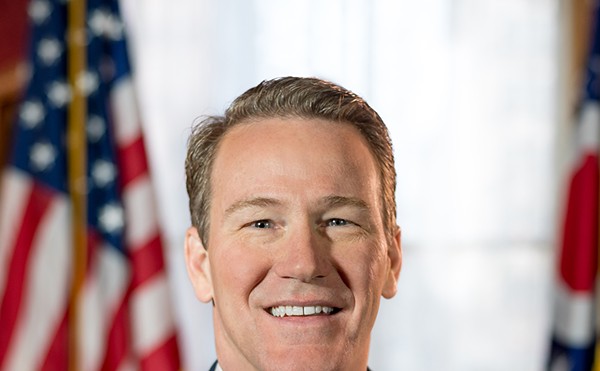
Aftab Pureval, Hamilton County’s freshman clerk of courts, pushed his office to the forefront of the Ohio living wage movement Tuesday by declaring a $16-an-hour minimum wage for most of his 212 employees as well as paid leave to care for newborns and sick relatives.
The new baseline wage — $16.48 to be exact — covers those workers who earn less than $30,000 a year, Pureval says. Those earning between $30,000 and $60,000 will receive a 1 percent raise. The raises will take effect in less than a week and boost the pay of all but 10 employees.
A third policy change was neither about pay nor benefits. Although the Hamilton County administration forbids discrimination against employees for sexual orientation and gender identity, the policy doesn’t automatically apply to the county’s elected offices. The clerk’s office’s new policy against discrimination includes LGBTQ employees as a protected class.
Pureval, who last November became the first Democrat elected to the court clerk’s job since 1903, says the raises were long overdue.
“I was shocked that the clerk’s office has been able to retain so many folks for decades while still underpaying them,” he told CityBeat. “These are folks who come in every day, who work hard and diligently and are committed to public service and serving the citizens of Hamilton County — and our office had been woefully undervaluing and underappreciating them.
“Our staff is the greatest resource that we have, and they’ve earned these salaries and these benefits through their hard work."
Worker advocacy groups and elected officials around the country have been clamoring for higher minimum wages, with mixed results. Last December, the Ohio Legislature and Gov. John Kasich enacted a bill preventing cities from establishing citywide minimum wages above the state’s own minimum, now at $8.15 an hour. But local governments have the legal authority to raise minimum pay for their own workers, as Cincinnati did in 2016 when it went to a $15 an hour base for its full-time workers.
Franklin County set a $13.69 hourly minimum wage for its employees in 2016. Just last month, Cleveland Mayor Frank Jackson announced his intent to raise the minimum for that city’s workers to $15 an hour.
“Better paid workers are generally better workers,” says Amy Hanauer, executive director of Ohio Policy Matters, a think tank with offices in Cleveland and Columbus. “Raising worker wages increases stability and retention, eases recruitment and can help workers to thrive in a job. When public employees are paid poverty wages, they are more likely to need public assistance, and their children are less likely to thrive long-term, so government often ends up facing increased costs anyway.”
Pureval says raising his employees’ pay was “the right thing to do.” He says one 17-year employee never topped $12 an hour or $30,000 a year in spite of being a high achiever.
“Hamilton County is an incredibly modern community, and to be undervaluing a top performer like that to that degree has to change,” he says. “With these salary increases and those benefits, it is changing.”
Pureval’s new family leave plan is just as ground-breaking. The federal Family and Medical Leave Act of 1993 requires employers to give workers up to 12 weeks of leave in the event of pregnancy, family illness or adoption, among other occasions. Nothing, however, requires them to keep paying those workers, and that is the case under current Hamilton County policy.
The new policy in the court clerk’s office, effective Aug. 1, will give workers six weeks of paid parental leave — to both mothers and fathers. Those with at least five years of service will receive 100 percent of their pay. Those with less than five years will be subject to a sliding scale topping out at 70 percent. The office will provide two weeks of paid leave to care for sick family members.
“We have a lot of staff who are the primary care-givers for their families and also for their sick relatives,” Pureval says. “They take a lot of time before and after work caring for those family members, and if you’ve never been in that situation, it’s incredibly stressful. It’s difficult to choose between a paycheck and caring for your loved ones, and with this two-week benefit, thankfully we won’t have to force employees to choose that.”
Keary McCarthy, president of the Innovation Ohio Education Fund in Columbus, says Summit and Lucas counties and the cities of Cincinnati, Dayton, Columbus and Newburgh Heights offer paid family leave.
“Every other country in the industrialized world requires some form of paid family leave, and the United States has not caught up to this trend,” he says. “A policy that allows workers to earn a portion of their paycheck after the birth or adoption of a new child is good for both families and businesses. That’s why many Fortune 500 companies like Netflix and Microsoft have recently announced their own paid family leave policies.”
Pureval took office in January and wasted little time in making the office more responsive to public needs. He also fired about two dozen workers who either served as Republican Party officials or were related to former clerk Tracy Winkler, including a nephew, a cousin’s wife and a son-in-law’s brother.
“This is a direction toward merit being the fundamental driver in determining your success in the clerk’s office, not who you know or what party you’re part of,” he says.
Pureval’s $12.8 million budget for 2017 is down slightly from $13.1 million a year ago. He says about 73 percent of the budget goes toward personnel expenses. And the cost of the raises and paid medical leave, he says, was so outweighed by the savings from the firings and other measures that he is spending “hundreds of thousands of dollars” less than the office did last year.
“We reduced the size of the office, we streamlined, we created efficiencies and we cut waste,” Pureval says. “That’s how we were able to afford these changes while still being well within our budget, while saving taxpayers’ dollars and while spending less on personnel than the previous administration.”
CONTACT JAMES McNAIR: [email protected], 513-914-2736 or @jmacnews on Twitter





